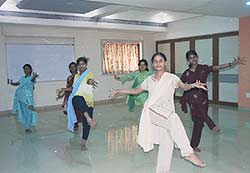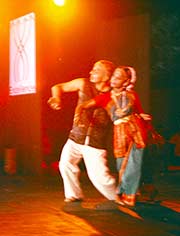Home > News > Specials
The Rediff Special/Shruti L Mathur
November 17, 2003

The six Bharata Natyam dancers troop through the door. They all yell good morning to their dance collaborator, who jokes around with them. "Hey Karthika, fashion plate?" he grins at one of the dancers who is wearing a new churidar kurta.
But the joking lasts only a minute. Within five minutes of walking though the door, they are in position, ready to practise their first number, Pushpanjali.
Pounding on the floor, the dance collaborator starts the music and critically watches the girls perform. Periodically, he yells directions at them, correcting their mistakes.
Soon, the Pushpanjali is over. The girls now cluster into a group to prepare for their next dance, a Thillana. They talk amongst themselves, waiting for the music to start. The dance choreographer calls one of them; he wants to give her further instructions. "Jamuna!" he calls. "Jamuna! Come here!"
Jamuna appears to not hear him. The other dancers tap her on the shoulder and point her towards the instructor. She quickly rushes over to 'see' his instructions.
The reason Jamuna doesn't hear him is because she -- and the other dancers in the group -- are hearing impaired.
They are in Mumbai because of Astad Deboo, the critically acclaimed, famous contemporary Indian dancer who has spent the last 16 years working with hearing impaired dancers from the Kolkata-based hearing impaired theatre troupe, The Action Players.
These Bharata Natyam dancers are students at The Clarke School For The Deaf in Chennai. Deboo got involved with them while looking for a classically-trained dancer to perform with The Action Players at the Deaf Way II Conference in Washington, DC in July 2002. He zeroed in on Karthika, who flew with him and The Action Players to America for the symposium, where they were the only Asian country to perform as well.
Since then, Deboo and the Clarke dancers -- R Karthika, H G Divya, T Mahalakshmi, S Gayathree, Jamuna Rani and H Mahalakshmi -- have performed together four times. The girls are handpicked early on in school because of their capacity and urge to dance said the school's dance instructor, V Narayanee Venkatasubramanium.
The girls have varied reasons as to why they decided to take up dance. Karthika, who danced with Deboo in Washington, said, "I used to watch small dance pieces on television when I was young and that inspired me to dance."
Mahalakshmi's grandmother is a dance teacher and so is her elder sister. "I saw my elder sister dancing and it interested me," she said. Her sister is also hearing impaired.
Jamuna liked the make-up, the costumes and the jewellery.
Most of the girls were born deaf, except for Mahalakshmi -- she was pushed in a game and hurt her head resulting in her becoming hearing impaired when she was six.
Their range of hearing also varies. Two of the girls can hear the difference between a low-pitched sound and a high-pitched sound and between voices and instruments. Gayathree, however, is completely deaf, despite the hearing aid in her ear.
Venkatasubramanium has also taught students who can hear. She says the difference in the two groups lies in their memory. "Normal people might learn a step immediately, but they will also forget it immediately. These people don't forget," she says, pointing to the girls around her.
The girls learn the dance by memorising the dance counts in their head. The majority of them can hear the start of the music after which they count the rest of the dance in their heads.
Deboo says it is the girls' ability to remember the dance that makes it easy for him to train them. "What is nice is that, during my absence, they keep it going," he adds.
Venkatasubramanium says it can be harder for the girls to learn because they need to remember three things -- counting the steps, facial expressions and head gestures; most dancers only need to remember the movements. The girls don't agree. "It's simple," says Karthika with a smile.

Besides the classical Bharata Natyam they learn at school, Deboo has taught the girls two modern pieces which they call 'the slow dance.' They like the pieces and say they were easy to learn. Mahalakshmi, however, admits that while learning the dance was easy, perfection was difficult. "The facial expressions and feelings were difficult," she says.
Divya explains further, "Both styles of teaching [Deboo's and the way they are taught at the Clarke school] are different, but we understand. In classical dance we have more of steps and more of rhythm, but the way Astad teaches is more of facial expressions and feelings."
Deboo doesn't excuse the girls' mistakes. When Jamuna forgets yet again to leave enough space between her and the next dancer despite several reminders, he gets annoyed. She listens with a grave face, nodding, and then tells Deboo, "Thank you."
The girls enjoy working with him. "It's nice when we are dancing together," said Divya, "but when he gets angry, we feel tense. But it helps us because we also work for perfection."
Deboo said the only time he shouts is when he has to correct them for the same mistake repeatedly. "I just blow a fuse," he says. "But it's just to push all of them, hearing or non-hearing, to achieve a certain standard of excellence."
When asked how dancing makes them feel, the girls answer at once, "Happy!"
Mahalakshmi adds, "Everyone says I dance well, so I feel happy."
Jamuna says, ""When they clap, though I can't hear, I see them clapping. It makes me happy."
Lakshmi Mahed, the girls' academic teacher at school, said many audience members don't realise the girls performing before them on stage are hearing impaired. Divya said she feels happy when that happens; she likes the shocked expression on people's faces when they realise the girls perform complicated dance compositions despite being unable to hear the music.
In their free time, Mahalakshmi and Gayathree like to shop, while Mahalakshmi likes to surf the Internet. Jamuna enjoys roaming around and Divya loves watching movies at the cinema. Karthika likes to practise her dance steps.

The girls' career interests are as varied as their fun activities. All six girls want to head into different fields. Gayathree wants to do business while Karthika wants to become a dancer. Jamuna doesn't know what she wants to do, but as long as whatever she does is in America, she is happy. Mahalakshmi wants to become a doctor. She also wants to learn computers. As does Divya, who only plans to work if her husband doesn't earn enough!
Talk about marriage, and they all giggle like the schoolgirls they are. Divya and Karthika dream of marriage, but none of the others list it as a preference. Jamuna says she will "search for the handsomest guy and marry him." Otherwise, she is not interested. Divya thinks she has already met the perfect man in her boyfriend at school, but shyly declines to say anything more about him.
The girls have a few friends outside their school, but most of their companions are other hearing impaired children. Jamuna says 'normal' girls look at them differently.
"They can't understand what we speak," says Divya, "but we can write and show them."
Some kids can be cruel and tease the girls about their voices (most hearing impaired children are unable to speak or sound unintelligible because they have never heard words and, hence, don't know how to pronounce them). "Other people laugh and mock us," says Divya, "but we don't feel it. We just ignore it."
Mahalakshmi feels sad that others are not able to understand what they (the deaf girls) say. "We want to talk to everybody," she says.
They are excited about the doors that dancing has opened for them. It allowed Karthika to travel to the US and took Jamuna and Mahalakshmi on their first-ever flights. Mahalakshmi is scared of flying but is willing to try it again because she "wants to see things."
At the girls' performance in Mumbai on November 14, Deboo explained to the audience that the right way to applaud in the deaf world is to wave your hands towards the stage.
Jamuna and the others, as usual, didn't hear the sounds of clapping, but they could see the sea of hands, silently waving their appreciation.
Click here for more specials
Photos: Shruti L Mathur
Image: Dominic Xavier